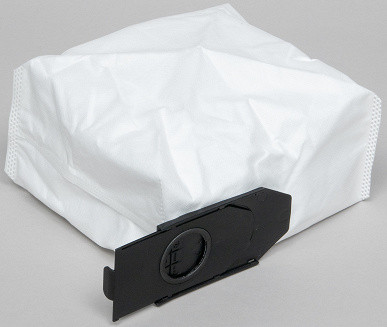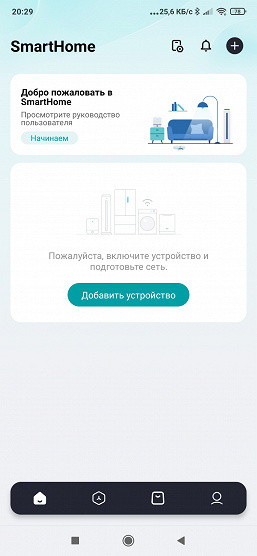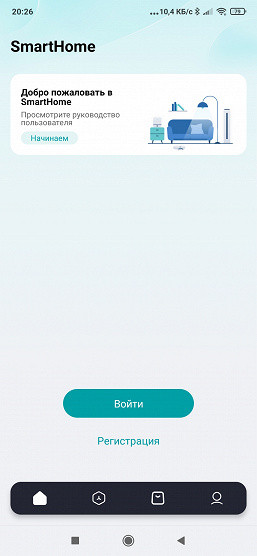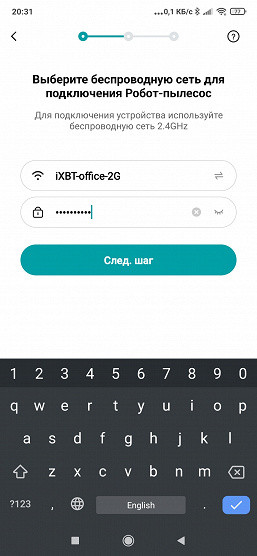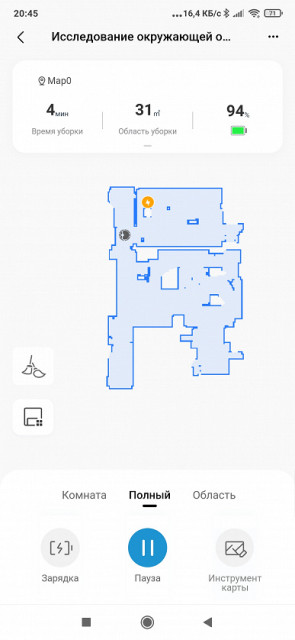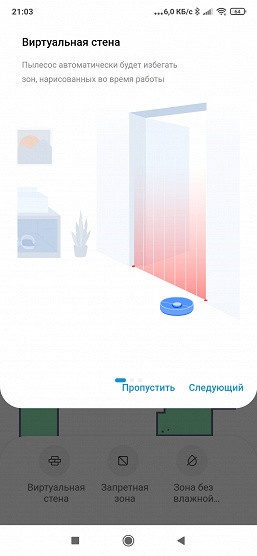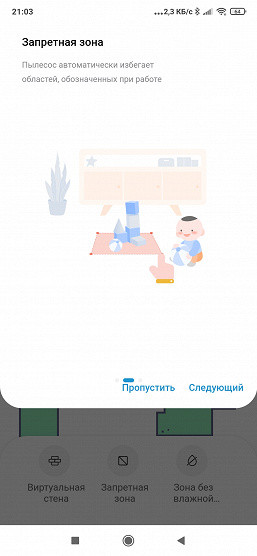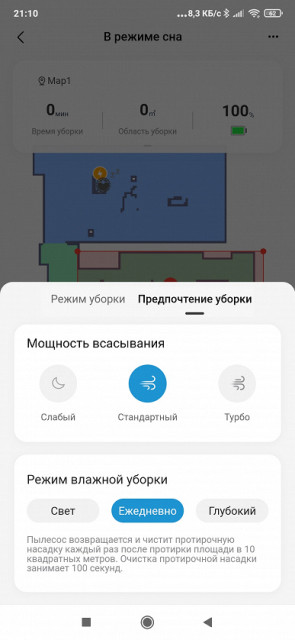The Midea V12 robot vacuum cleaner is a modern model with a self-cleaning station function and automatic mop washing and drying. Despite the fact that such devices belong to the top segment, the Midea V12 has a more average cost compared to similar models of other brands, which can cost one and a half to two times more.

Let's see what happens if we try to save a little and opt for a more affordable model.
Characteristics
| Manufacturer | Midea |
|---|---|
| Model | V12 |
| Type | robot vacuum cleaner with self-cleaning station |
| Country of origin | China |
| Guarantee | 1 year |
| Service life * | 3 years |
| Sensor type | LDS (lidar), infrared, mechanical |
| Type of cleaning | dry, wet |
| Power | Maximum suction power 66 W |
| Suction power | 5000 Pa |
| Maximum noise level | 56 dB |
| Self-cleaning station | There is |
| Battery | Li-Ion, 5200 mAh |
| Opening hours | 150-180 minutes |
| Wireless control | Wi-Fi, 802.11a/b/g/n, 2.4 GHz |
| Vacuum cleaner dust container capacity | 250 ml |
| Dust container capacity of the docking station | 2.5 l |
| Dock station water tank capacity | 4.7 l |
| Dirty water container capacity | 2.5 l |
| Weight with self-cleaning station | 16.5 kg |
| Weight of the vacuum cleaner | 4.6 kg |
| Dimensions | 350×342×108 mm |
| Length of network cable | 1.5 m |
* Contrary to popular belief, this is not a period after which the device will necessarily break down. However, after this period, the manufacturer ceases to bear any responsibility for its functionality and has the right to refuse to repair it, even for a fee.
Equipment
The vacuum cleaner is packed in a large cardboard box with the signature Midea design in blue and light blue tones. The front side shows the vacuum cleaner itself with the main technical characteristics, and on the side there are additional photos that help to get acquainted in detail with the functions of the robot and the self-cleaning station.
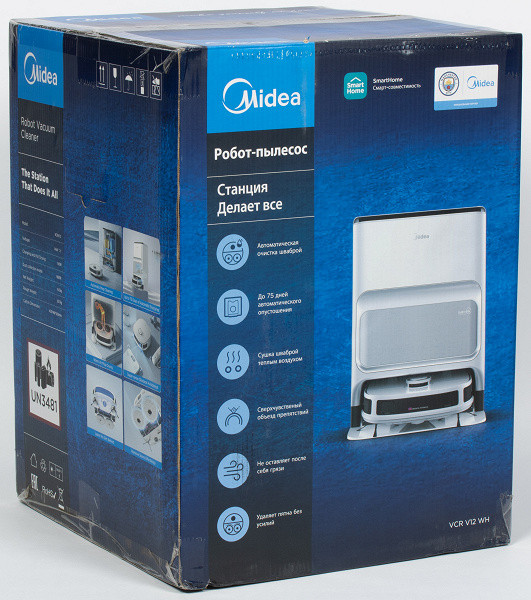
Inside, as is usually the case, we found another box — for the vacuum cleaner itself and accessories, as well as a cleaning base.

The package includes:
- the vacuum cleaner itself with a dust container
- a cleaning and charging base
- a spare disposable dust bag (the first one is already installed in the base)
- a set of side brushes (2 pieces)
- two mop holders with installed napkins
- a cleaning brush
- an electric cord
- a user manual
- a warranty card
Important: if you purchased a robot vacuum cleaner through official sales channels, there should be a warranty card in the box, providing a 1-year warranty. When purchasing through unofficial channels, the card may be missing, in which case warranty service is not provided.
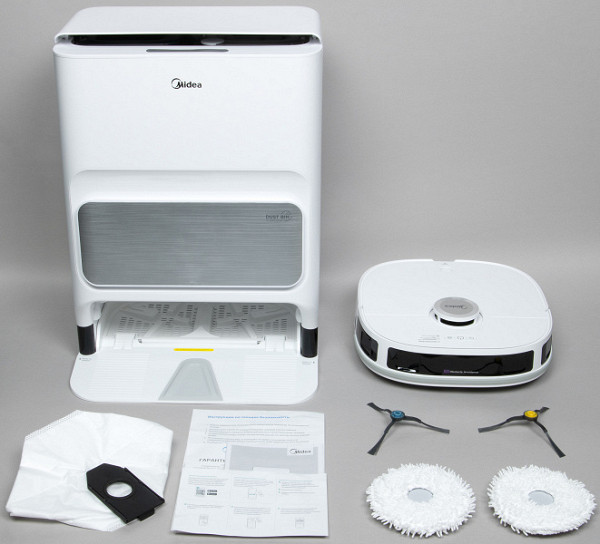
The package is standard and includes everything you need to run the vacuum cleaner. The package includes a spare dust bag, but replacement brushes, additional mop cloths and spare bags will have to be purchased separately.
At the time of writing (June 2024), the manufacturer states that accessories will be available for sale soon. For now, information on prices and availability of these products is not available.
At first glance
Let's take the contents of the box out and take a closer look. Let's start with the robot itself. Its body is not quite round, but rather square with rounded corners. The main material is white plastic of good quality, it looks neat and stylish.
The dimensions of the robot are slightly larger than standard: the length of one side is 35 cm. The manufacturer's logo is located on the top panel, and there are three control buttons at the top.
In the center, closer to the front edge, there is a lidar turret, where the laser emitter and receiver rotate at high speed.
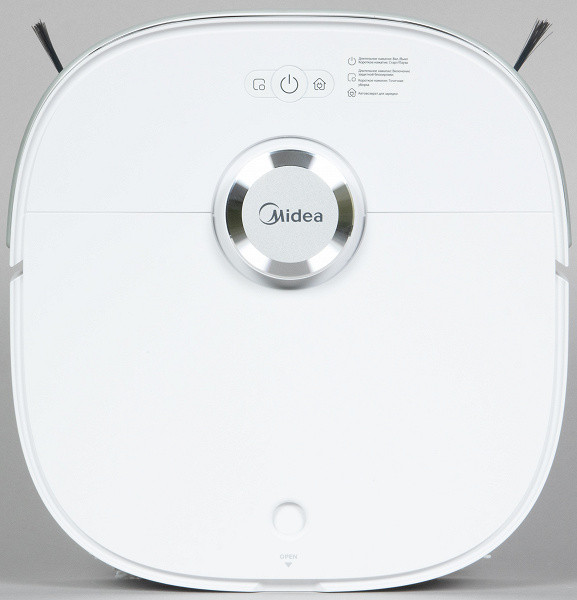
With the help of the LDS system, this model detects the boundaries of the room and the placement of obstacles, creating an accurate and detailed map in a matter of seconds. The Midea logo can be seen on the tower itself.
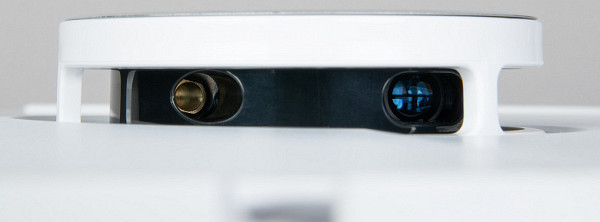
The robot has a movable bumper at the front, which serves as a physical collision sensor. A rubber strip is glued to the bottom of the bumper to soften impacts. Traditional infrared sensors are located in the center and on the sides of the bumper.

Continuing to examine the sensors, on the right side we see a special sensor that helps the robot measure the distance to the walls. This allows the device to move along the walls almost closely.

There are no additional sensors on the opposite side.

On the back side, attention is drawn to the contacts for charging the robot, as well as the hole for sucking out debris from the robot's dust collector.
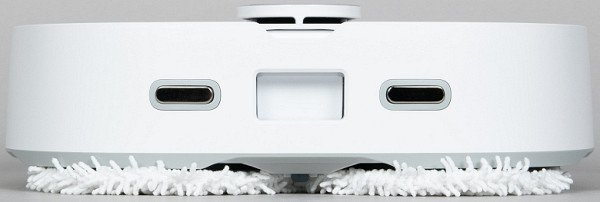
And here we suddenly discover that our robot has no water filling port. This was a real surprise for us, since we expected to see a full-fledged wet cleaning robot that automatically fills with water at the base and uses mops to regularly moisten the floor. However, in our case, mops, containers for clean and dirty water, and a mop cleaning system are present, but the moistening function during cleaning is missing. How this will affect real operation, time will tell.
As for the chassis, it is made according to the traditional scheme: two drive wheels set the robot in motion, and an additional support wheel is located in front. Pronounced protectors on the wheels provide reliable traction on various types of floors.

Let's note right away that the robot is equipped with six surface sensors located in front and on the sides, which prevent the device from falling down stairs or other height differences.
This model also has two side brushes: right and left.
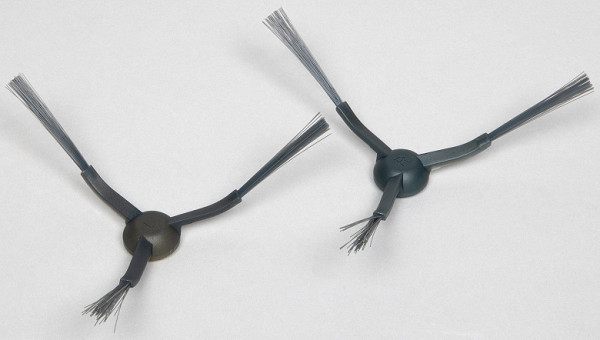
They differ in the color of the plastic and have markings in the form of the letters L and R.
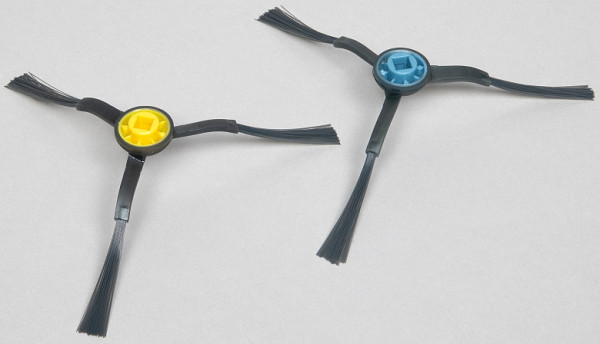
The brushes are attached without any special tools, using a regular latch, and are held on the axis securely and firmly.
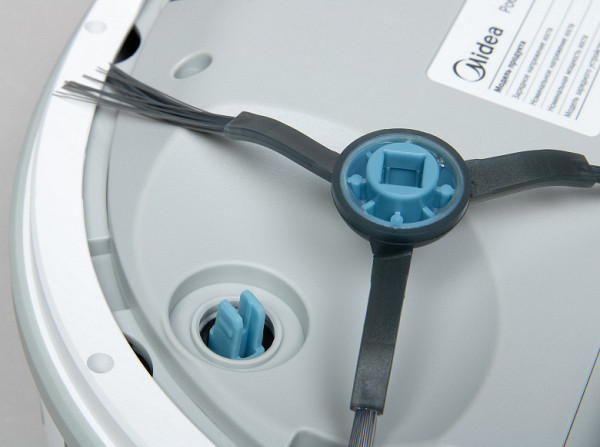
The central brush has the usual rows of bristles alternating with V-shaped slats.
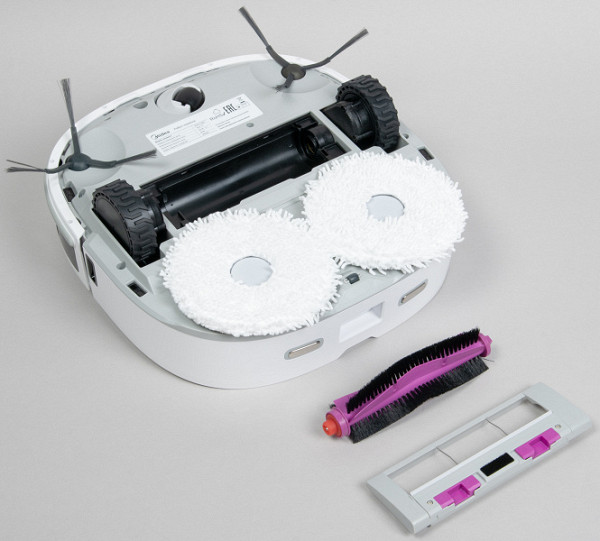
The brush frame is equipped with two jumpers that prevent threads, wires and other small objects from getting tangled. Midea developers paid special attention to protecting the brush from hair and animal hair getting tangled when developing the new design.
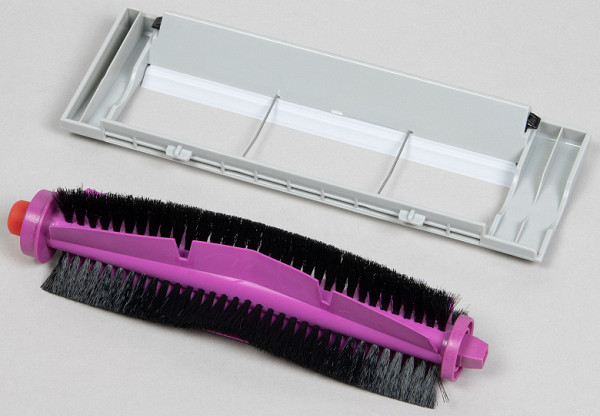
For wet cleaning, two “mini-mops” are attached to the bottom of the vacuum cleaner. They consist of a plastic base and a cloth made of white fleecy fabric, which is fixed with Velcro.For wet cleaning, two “mini-mops” are attached to the bottom of the vacuum cleaner. They consist of a plastic base and a cloth made of white fleecy fabric, which is fixed with Velcro.

The mop bases are held in place magnetically, making them easy to install and remove.
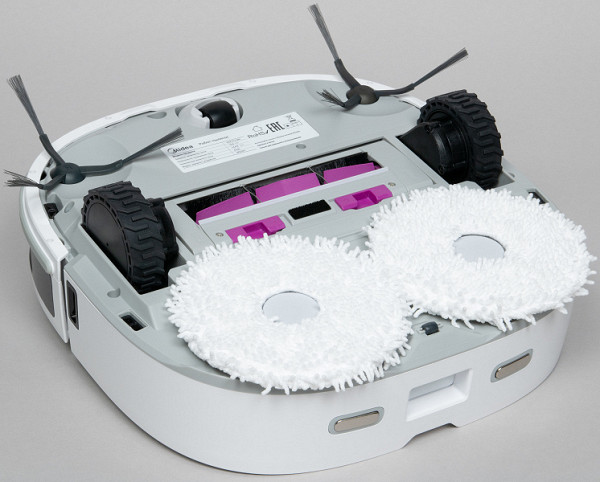
The robot is not capable of lifting mops, so it will wipe the floor even on carpeted floors. The battery compartment is located at the front of the device and requires removing the front of the bottom panel to access it.

The vacuum cleaner battery consists of eight AA-size cells covered with heat-shrinkable film, with a nominal capacity of 5200 mAh.
Now let's turn the robot over again and look under the cover. Under the top hinged panel, you can find the serial number of the device and a QR code for installing the proprietary SmartHome application. Nearby, there is also a Wi-Fi connection indicator and a recessed reset button.

Hidden under the rubber cap is a USB port. Although the manual doesn't mention it, the manufacturer's technicians explained that this port is for manually updating the device's firmware.
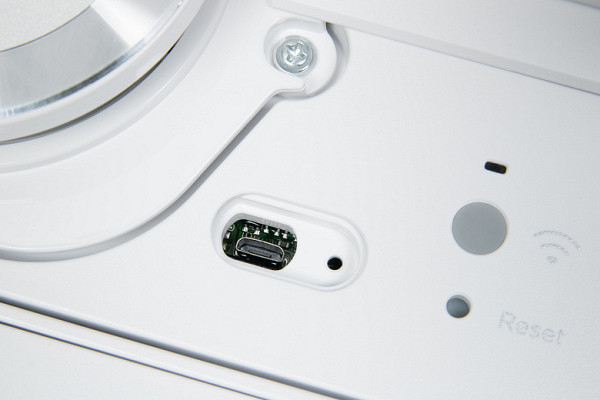
There, under the lid, is a hidden waste container.

The container is made of translucent grey plastic and is easily removed using a folding handle that also locks it in place. Under the container's hinged lid is a large HEPA filter...
… And under it-a filter skeleton made of synthetic material.
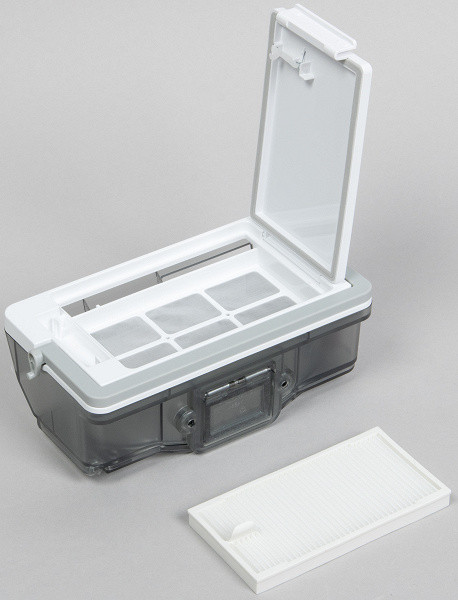
If there is a need to empty the container manually, click on the latch button and open a special hatch.
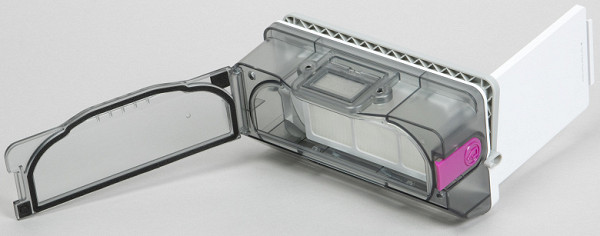
Now take a look at the base station.
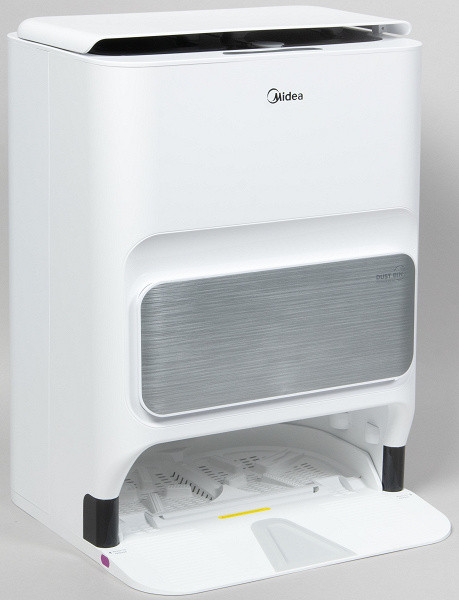
The base looks impressive: in addition to the parking lot for the vacuum cleaner, there is a compartment for collecting dry garbage and two water containers. In the upper part of the base there is a logo and a control panel, which also serves as an indicator of the state of the robot.
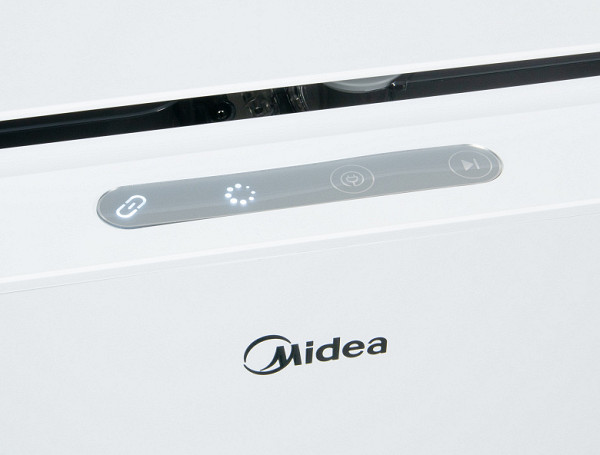
On the back we see the place of the release of the electric wire and the compartment for winding its excess
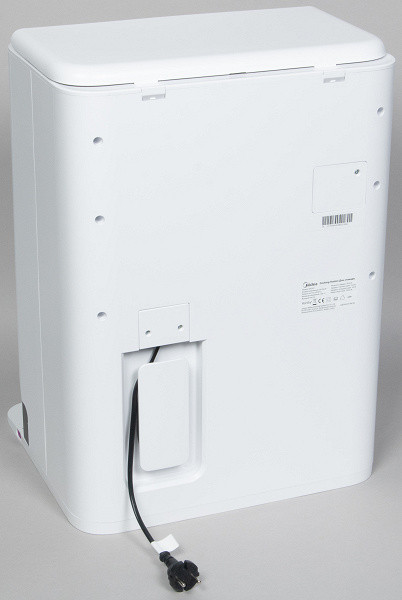
Below-anti-slip stickers-legs.
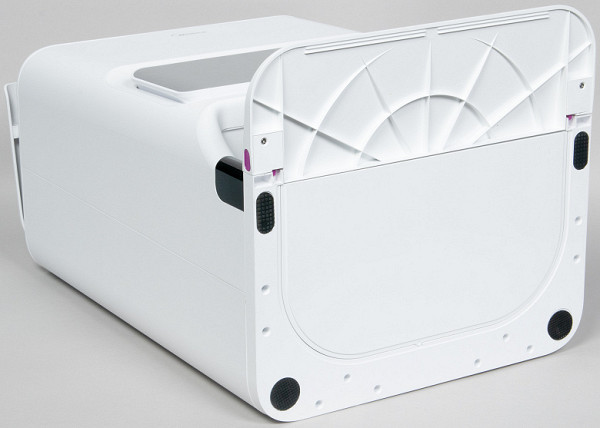
The base station is equipped with a large console, which the robot enters on its own. To dismantle it, click on the side buttons.
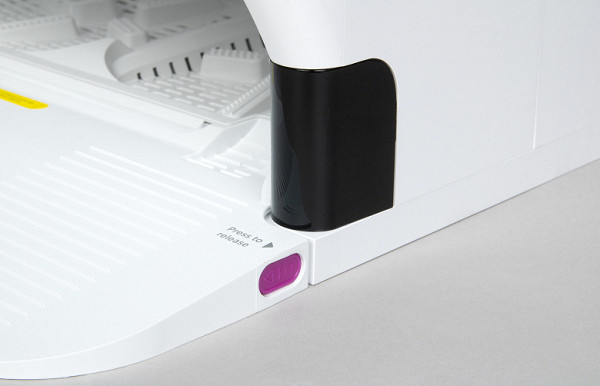
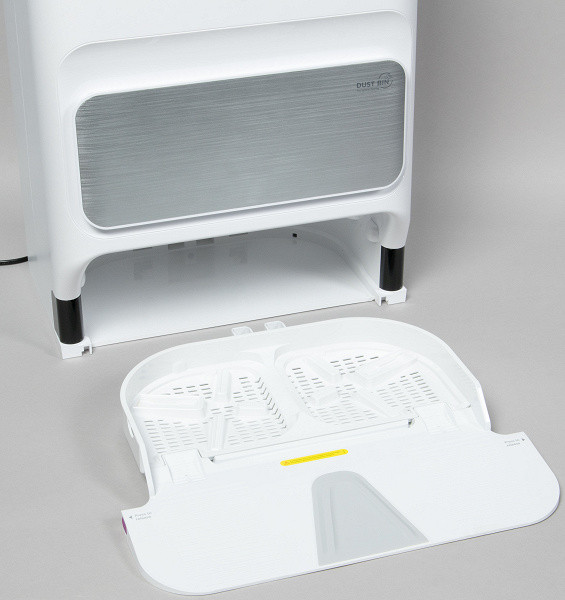
The console has special protrusions for washing a mop. Since the console itself is removable and collapsible, it is easy to wash.
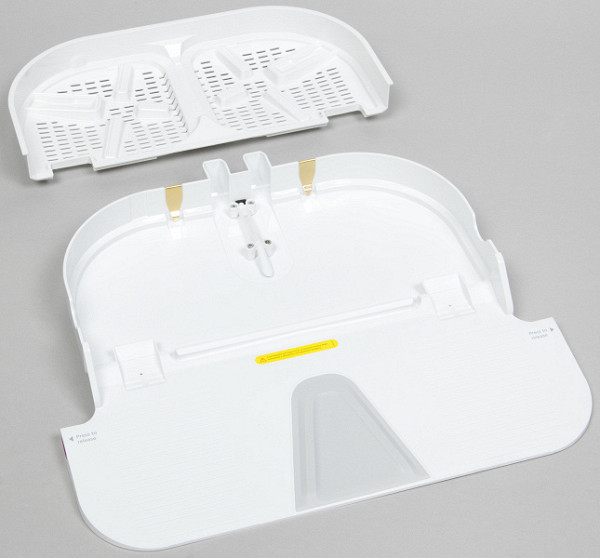
In the niche in which the vacuum cleaner is parking, in the center we see a hole for discharge of garbage. On the sides of it are spring -loaded contacts for charging.
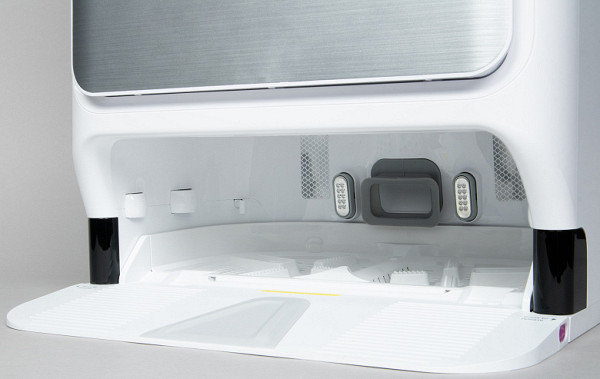
Under the removable side cover is the garbage compartment.
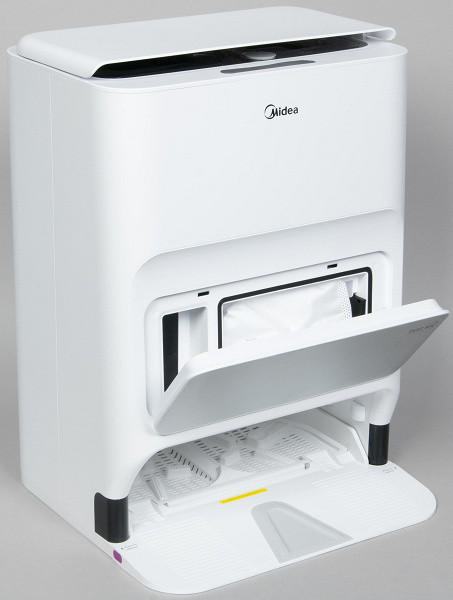
On the back of the lid we see an instruction sticker and a place to store the knife-brush.
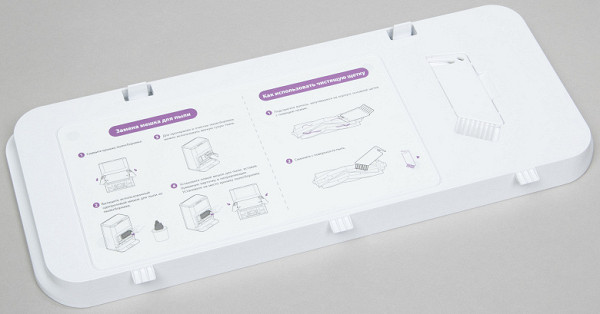
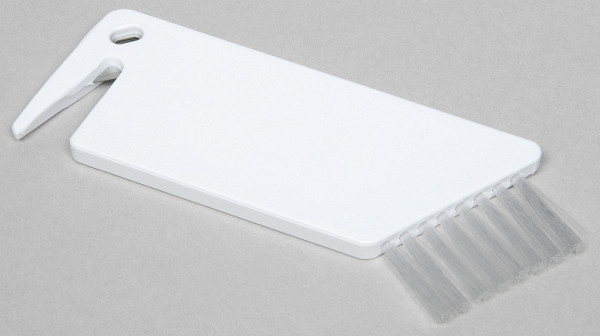
This is what the inside of the base looks like with the cover removed.
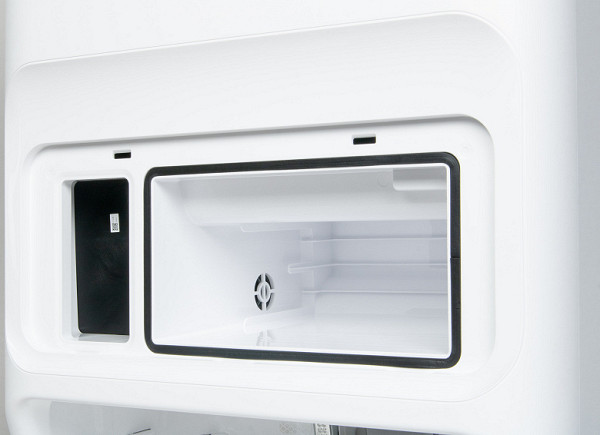
A disposable bag is installed here, into which the collected dust will fall.
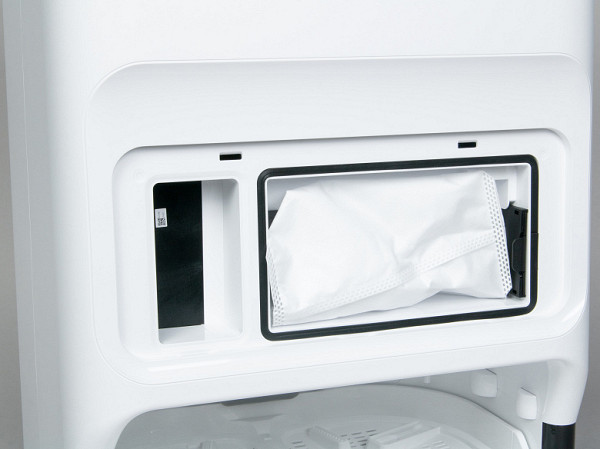
The bag has a plastic frame instead of the usual cardboard one, which makes its installation quick and easy. The latch securely closes the bag when removed, ensuring that the contents do not spill on the way to the trash can.
The frame attachment point is equipped with a mechanical sensor: self-cleaning will not start if the bag is installed incorrectly. The grille that hides the stationary vacuum cleaner is protected by a simple filter that will prevent damage to the device if the bag breaks and debris gets inside.

At the top of the base there is another (this time — folding, not removable) cover. Under it there are compartments for installing containers for dirty and clean water.

Let's take a closer look at the containers. The container for clean water is made of light translucent plastic, and the one for dirty water is made of dark plastic. This solution eliminates confusion and keeps the inside of the base neat, even if the container with dirty water is full.

For ease of carrying, both containers have a handle and a float sensor that determines the water level.
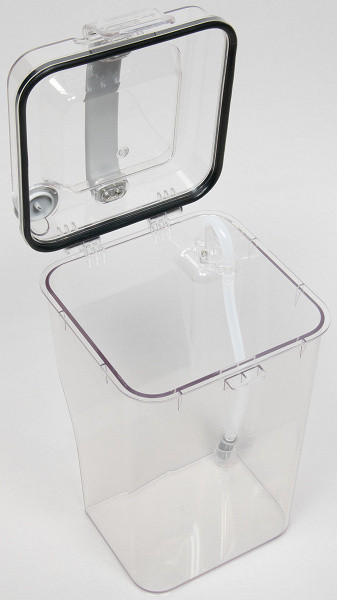
The containers have a lid with a rubber gasket and a plastic latch, which, when opened, allows you to easily pour or drain water, as well as wash the inside of the container.
Instructions
The user manual is a 26-page black and white booklet printed on medium quality paper.
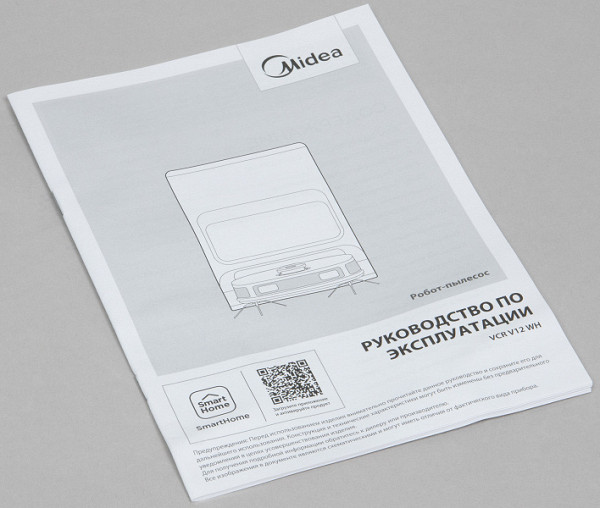
The content of the instructions is quite standard, the descriptions are clear, there are many illustrations, and, on the contrary, there are few typos.
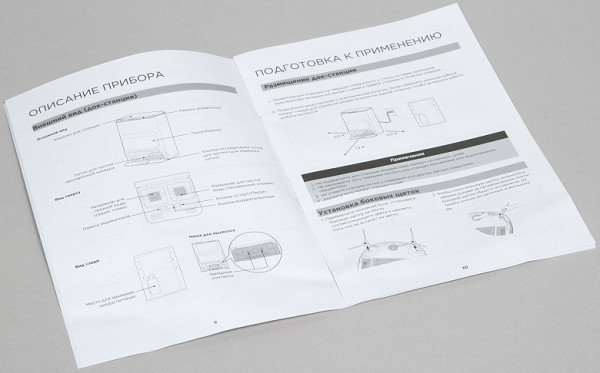
Also included in the kit we found a guide on how to connect to the app...
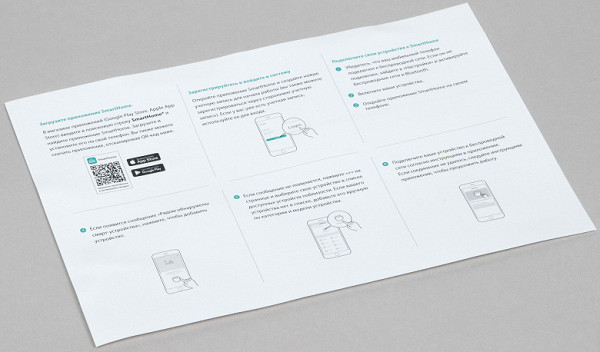
...and safety instructions.
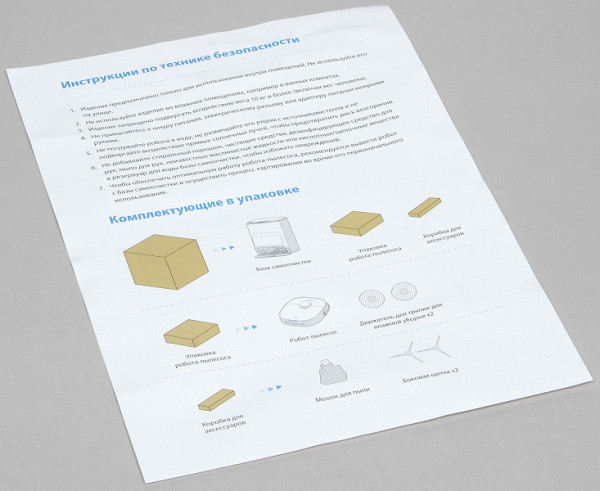
Control
The robot has few physical controls. There are three backlit buttons on the top panel. The first button is responsible for starting local cleaning (with a long press — for turning on and off the lock), the second — for turning the device on and off, as well as starting regular cleaning, and the third sends the vacuum cleaner to the base. The current active mode is highlighted by a white LED.

The red color of the indicators indicates a malfunction or low battery level.
The base also has indicators and control buttons. The first indicator shows the communication status between the vacuum cleaner and the docking station. The second indicator shows the current status of the vacuum cleaner, whether it is charging, cleaning, returning to clean the nozzle, charging or an error has occurred.

There are two buttons next to the indicators. The first button is used to start, pause and resume cleaning. The second button is used to send the robot to the station or to remove it from the station.
All functions and indicators, including colors and blinking indicators, are described in detail in the instructions.
Control from smartphone
The manufacturer recommends using the SmartHome app to control the robot. Although the app's functionality is not as wide as that of more advanced models, it is necessary for full control of the device. Through the app, you can manage maps and set up various cleaning modes.
To get started, you need to register by confirming your email address or mobile phone number.

Authorization via Google or Facebook accounts is also available. For the application to work correctly, permission to send notifications and access information about the device's location is required. As with most similar devices, only 2.4 GHz Wi-Fi networks are supported.
Synchronization of the application with the robot went smoothly: it was enough to place the smartphone next to the device, activate the pairing mode and enter the local Wi-Fi network data.
When starting work, the application gives the user some useful tips.
The first thing you need to do after installing the application is to create a map of the room. In this mode, the robot walks around the apartment and marks the location of walls, furniture, all sorts of obstacles, etc.
Once the map is completed, the apartment will be automatically divided into rooms.
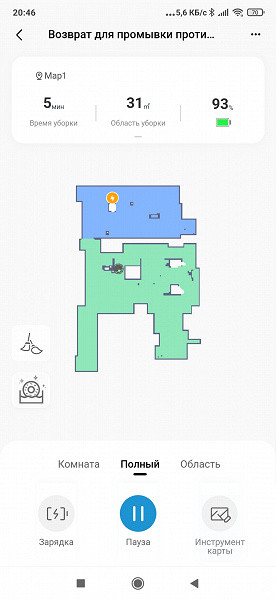
After this, the user can set up virtual walls and restricted areas (including separately specifying areas without wet cleaning).
This is what it looks like on the map.
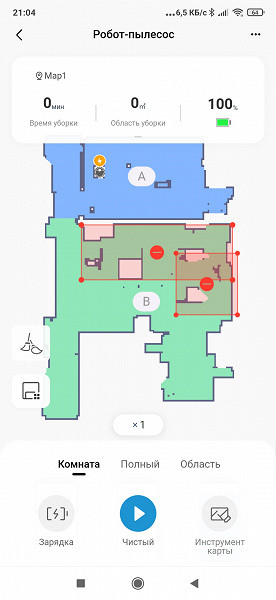
The app provides a limited number of cleaning settings: you can select a cleaning mode, adjust the suction power, and set the frequency of the robot's return to the base to wash the mops.
The wet cleaning modes differ in the number of square meters of floor after which the vacuum cleaner returns to the base to clean the mops. The «Light» mode (actually light) is designed for light dirt, and in this mode the vacuum cleaner returns to the base after wiping 14 m². In the «Daily Cleaning» mode, the vacuum cleaner processes 10 m² before returning to the base to wash the mops. The «Deep» mode is designed for heavily soiled floors, and in this case the vacuum cleaner returns to the base every 8 m².
You can also adjust the dust discharge frequency and turn on the automatic drying mode on the base. It is worth noting that the translation of some terms and menu items is not entirely accurate, and sometimes you have to guess the purpose of certain buttons.

The application also has the ability to switch to manual control mode for the robot...
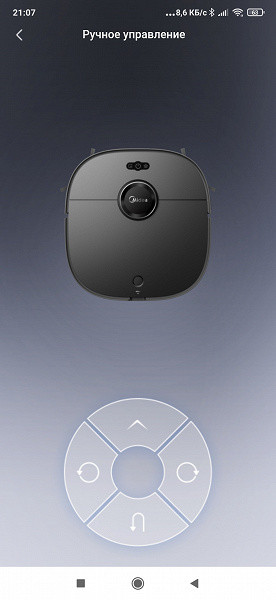
...monitor the wear of consumables...

...activate the spot cleaning mode in corners and/or the “increased caution” mode, in which the robot will more carefully avoid collisions with obstacles.

Overall, we rate the app as decent. It performs the main functions, and there are enough settings. All that's left is to correct the typos — and it will be pretty good.
Operation
Before using the vacuum cleaner and the base, remove the packaging materials and stickers, and remove the soft transport pads between the robot body and the movable bumper.
When installing the base station, it is important to leave at least 1.3 m of free space in front of it and 0.5 m on each side. Also make sure that the vacuum cleaner is in a stable wireless reception area.
Install the side brushes until they click into place and place the dust bag in the base (if there is none). It is recommended to fully charge the device before first use. The first charge may take longer, so it is better to leave the vacuum cleaner on the base overnight.
Although the vacuum cleaner can be used without the app, you should install the app immediately to fully utilize its capabilities.
Thanks to the lidar, the robot quickly navigates the room, accurately determining its layout and noticing obstacles. When used for the first time in an unfamiliar room, the robot creates a map, displaying walls, furniture, and other objects on the mobile app screen. Small objects, such as slippers, are carefully avoided by the robot, but can get tangled in wires.
Once the map is created, you can edit it manually, setting up restricted areas and areas where wet cleaning is not required.
When cleaning is complete, the vacuum cleaner returns to the station, connecting the plates on the body with the contacts on the base. Then the stationary vacuum cleaner turns on, which blows out the dust collector and removes the debris into a disposable bag. When the bag is full, it needs to be replaced with a new one. You can also try to remove the debris through the hole, although this is not the most convenient solution.
Wet cleaning is carried out as follows: the robot washes the mops, then cleans along the perimeter and in a serpentine pattern in the center of the room. After cleaning 10 m², the vacuum cleaner returns to the base to wash the mops and continues cleaning from the place where it stopped. This allows both the mops to remain clean and the floor to receive a sufficient amount of water.
This mode increases the cleaning time, since the robot spends time returning to the base and washing the mops. However, if there is no need to rush, this is an effective way to maintain cleanliness.
After wet cleaning, the vacuum cleaner returns to the base, cleans the mops and dries them with hot air for about two hours. The noise level is minimal, so drying can be done even at night.
The user needs to periodically drain the dirty water from the container and fill it with fresh water. This does not need to be done every day, but you should not keep the dirty water for too long.
The vacuum cleaner reports on the cleaning progress via the voice interface.
Final impressions:
Pros: The robot navigates the room well, effectively performs wet cleaning, automatically dumps dry debris, washes and dries mops.
Cons: The robot itself does not have a water container, problems with wires, minor movement of small objects and scattering of debris.
App: The rating is “four with a minus” due to many typos and not always clear menu items. Despite this, it works properly.
Care
Our robot requires minimal user intervention to maintain it in working order. In everyday use, it is enough to just drain the dirty water, and a little more often — refill the clean water tank. As it fills up, you should throw away the garbage bag, which is located inside the self-cleaning station. Even less often, you need to clean the HEPA filter and cut off hair and threads wound around the brushes.
The garbage bag is usually enough for 8-10 weeks of use, but if there are pets in the house, such as cats or dogs, it can fill up faster.
Also, as they wear out, you will need to replace the brushes and filters; the application will promptly remind you of this when the resource of these elements is approaching the end of their life.
It is recommended to check the condition of the sensors on the bottom of the device every month and clean them if necessary.
Conclusions
The Midea V12 robot vacuum cleaner left us with mixed, but overall positive impressions. This model has almost all the functions typical of modern top robots: laser navigation, an external dust bag, automatic washing and rinsing of mops. However, for some reason the developer did not equip the robot with a water container, which does not allow mops to be wetted during cleaning.
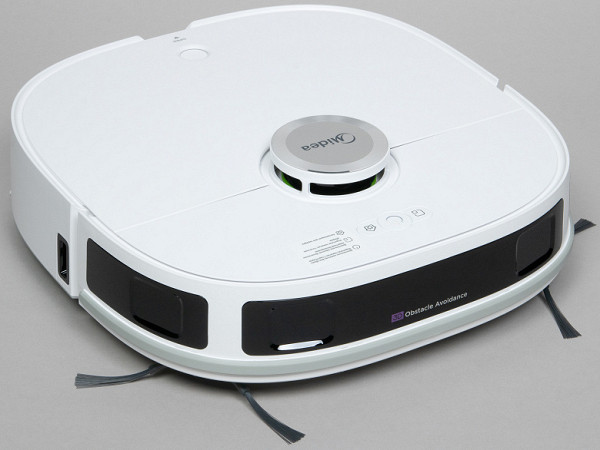
Let's be honest: the solution seems rather strange, especially considering that all the other functions inherent in top models are present here. The savings in this case seem questionable. Of course, this could have reduced production costs a little, but this did not affect the retail price in any way.
Nevertheless, the cleaning quality is quite decent and corresponds to the price category of the device: the robot effectively collects dry waste (although sometimes it scatters it with brushes), and wet cleaning is performed at a good level. Due to the fact that the robot regularly returns to the base and rinses the mops (after cleaning every 10 m²), the floors remain quite clean.
During testing, we had a feeling that we had already seen something similar. The thought arose that we had before us a slightly simplified version of another popular model. However, our attempts to find the original were unsuccessful, and Midea representatives deny such assumptions.
Pros:
- self-cleaning system
- high-quality navigation and cartography
- automatically rinses and dries mops
Cons:
- does not have a built-in tank for mopping
- relatively high price

